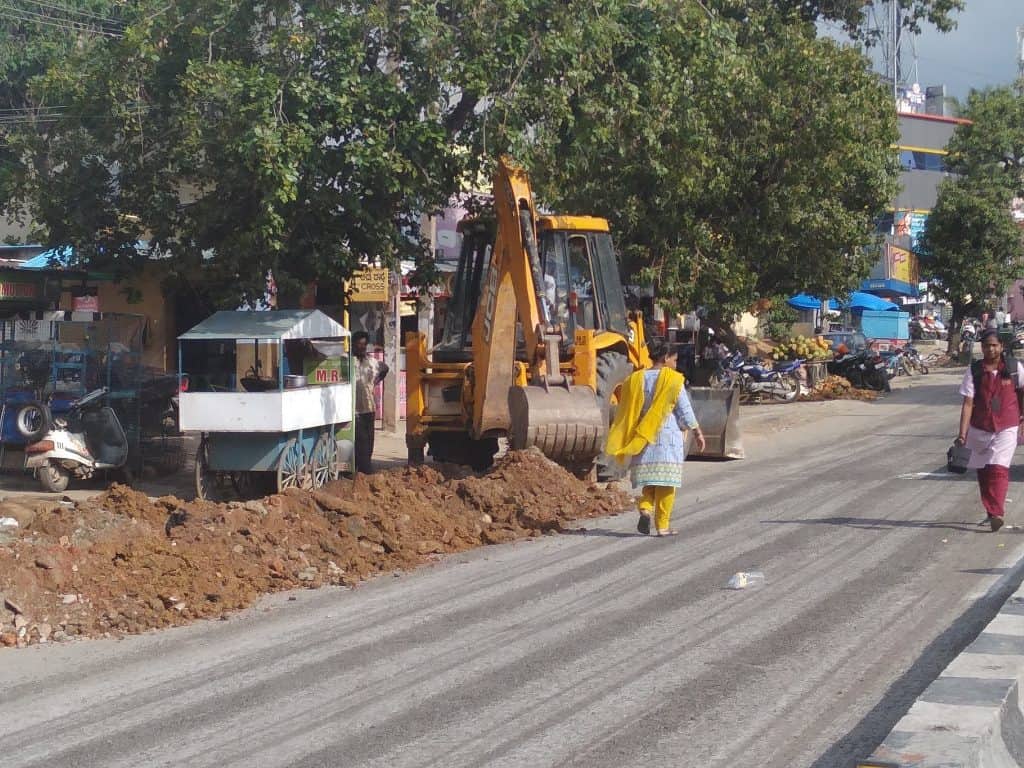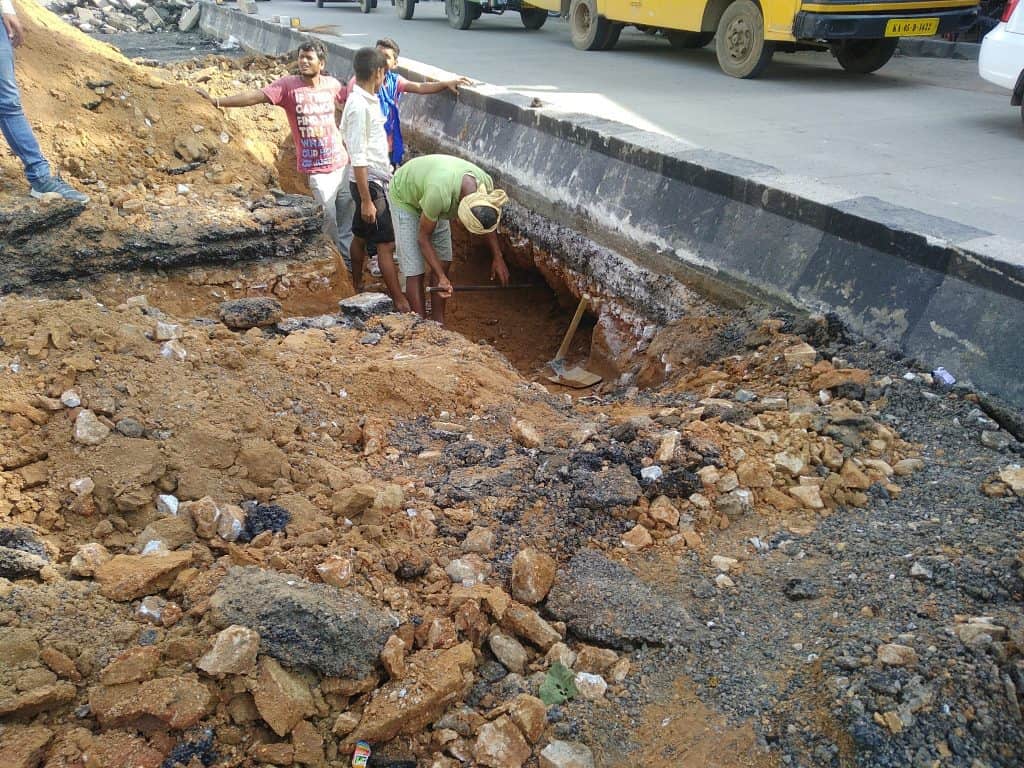They are not just a danger to life and limb. Bengaluru’s potholed roads are also inspiring artists and activists to get creative about their modes of protest at the poor state of the city’s roads.
While artist Badal Nanjundaswamy frequently takes inspiration from a well-formed pothole to unleash his creativity, Aam Aadmi Party activists recently held a Pothole Habba to “celebrate” the city’ potholes.
Bruhat Bengaluru Mahanagara Palike (BBMP), the city’s civic body in charge of ensuring road quality had, in 2018, come up with a grand plan of concretising roads to erase potholes, presumably (and disputably) forever. Called white topping, these are rigid pavements made primarily of concrete rather than black-topped or asphalt roads, called flexible pavements, made of crushed rocks and sand and bound by bitumen.
“The BBMP has completed white topping of 100km out of 150km of roads under the first two phases of the project,” says Lokesh, Chief Engineer, BBMP. Government nod is awaited to kickstart phase 3 which will cover 121.72 km, reportedly at an estimated cost of Rs 1183.11 cr.
White topping has its benefits
A section of Bengalureans has always looked with suspicion (in many instances rightly so) at large infrastructure projects and plans mooted by the government. White topping of roads seemed like yet another instance of waste of taxpayers’ money. Research, however, suggests that white-topped roads come with some benefits. For one, they are sturdier with little chance of developing cracks or potholes. So, these concretised rigid pavements could well be a long-term solution to recurring potholes.
Read more: “Revamp the entire system of road repairs – Why wait for rains?”
They are more expensive though, almost double the cost of laying asphalt roads. But their durability makes them more cost-effective. An argument often put forward by the BBMP to justify white topping.
Other than longer life, white topping also reduces maintenance needs. Associated benefits— in terms of both economic and productivity benefits—of better-maintained roads must also be considered here.
Another characteristic of white-topped roads is their high albedo effect as compared to asphalt roads. Albedo is the reflectivity of a surface. A surface with a high albedo reflects more solar radiation back into the atmosphere, while a surface with low albedo absorbs solar radiation. Asphalt roads thus absorb more heat, increasing surface temperature while white-topped roads reflect light, making the surface cooler.
One study says that reduction of absorbed solar energy using reflective pavements is a cost-effective approach to reduce the surface temperatures. The study further suggests the albedo of white-topped pavements in cities can mitigate Urban Heat Islands (UHI), a phenomenon where an urban or metropolitan area becomes warmer than its surrounding areas.
Sree Kumar Kumaraswamy, Head, Integrated Transport at World Resources Institute, however, believes white topping pavements alone cannot bring about changes in UHI. ”But it can contribute to cooling the surface temperature along with other factors like better tree cover”.

White-topped roads are also better to commute at night, especially in the absence of proper street lighting because it can reflect light better than a black-topped road. However, be warned that white-topped roads also contribute to more than the desirable amount of glare during the day, making riding stressful. Another study notes that the concrete surfaces of rigid pavements undergo various mechanical abrasions like tyre sliding and wheel rolling, reducing surface friction and making the road slippery and unsafe to use during wet weather.
Environmental impact of concrete
Studies on the environmental impact of cement suggest that concretising roads and buildings are not an eco-friendly solution to urban civic problems. The cement industry is one of the world’s most polluting industries. According to the Cement Association of Canada, 730 kg CO2 is produced for every 1000 kg of Portland cement.
A study comparing the environmental impact of asphalt and concrete pavements reveals that greenhouse gases emitted by asphalt pavements are just 51.9% of greenhouse gases emitted by concrete ones, mainly due to the chemical processes used in cement production.
Can white topping solve Bengaluru’s pothole mess?
Laying concrete pavements demands proper mapping of roads and planning with other civic agencies like BESCOM, BWSSB, etc before the roads are laid. You cannot dig it up every time there is other civic work to be done under it, which we see happen frequently in Bengaluru.
Read more: Urban Utilities Map Beku: What lies beneath Bengaluru’s roads
“You need heavy machinery to dig up a rigid pavement and it’s not cost-effective to keep digging a concrete road that’s already expensive to build,” says Prof Ashish Verma, Convenor, IISc Sustainable Transportation Lab.
Sreekumar concurs. “While white topping roads is a solution to bad roads in a city, the problem occurs when such projects are not planned edge to edge. Other services like sewage lines, manholes, etc that need frequent maintenance should run under the footpath and not under white-topped roads. For this, proper mapping of roads and coordination with other civic agencies beforehand is essential,” he says.

And Bengalureans fear that here’s where the BBMP will flounder. “The white-topped road opposite Forum Mall has already been dug up,” points out Koramangala resident S Sreeram who does not trust the BBMP to do a good job or complete the work on time. “White topping work on some roads in Koramangala that started before the pandemic is still going on,” says Sreeram. And the Ejipura flyover work that has been stuck for a long time is an example of why he thinks incomplete civic work in the city is a real menace and that white topping is only contributing to the chaos.
The news that the BMRCL will cut open the white-topped section of Outer Ring Road to erect pillars for the metro corridor too, has only added to the scepticism over the BBMP’s white topping plans.
Ashish believes white topping so many roads in the city is unnecessary. ”It is ridiculous that even the asphalt roads in good condition are being white topped,” says Ashish. “If properly laid and maintained, asphalt roads have a life of 5-10 years. But we end up laying roads every year because the authorities are not applying basic civil engineering solutions, resulting in citizens having to deal with terrible roads all through the year.”
“In the case of asphalt roads, bitumen binds aggregates like metal and sand. When water remains on the bitumen for a long period, a chemical reaction called the stripping effect happens wherein water strips the bitumen of its binding quality. And when vehicles run over it frequently, bitumen gives way and aggregates come apart,” he explains. “The civil engineering solution to this is to not let water remain on the road, with the help of cross slopes or camber in the road and rainwater drains on either side of the road. This is not being done diligently”.
There is no debate that Bengaluru needs better roads and that white topping has its benefits. But whether white topping all city roads is the most sustainable solution to the pothole menace is something that needs to be considered before phase 3 of the project kicks off.
White topping is a colossal waste of taxpayers’ money. The real solution is to build concrete roads with proper compaction of the base, sub-base, and follow the scientific methods of road building. Edge stoppers, camber, the thickness of concrete, the grade of the mix, and water retention capability, and many more Indian Standards of Road building.
[Ed: This comment has been edited as per our Comment Policy]
“Other services – – – should run under the footpath and not under white-topped roads. For this, proper mapping of roads and coordination with other civic agencies beforehand is essential”. This is where there’s a serious problem since none of the ‘stake-holders’ is answerable to BBMP, as it is structured today. And hence the urgent need for re-structuring BBMP, to bring its administration in alignment with the spirit of the 74th amendment.
Clause – Bangalore road should not exist more than a year…if exists eigther it should be removed with multiple attempts like metro line or fly over or under pass proposals. Simple ideas learnt by millineals by elder engineers don’t build a proper drainage system so that drainage water always cures cement throughout the area..
These topics should be included in civil engineering as mandatory otherwise Sir M V will feel bad about our advanced development.
No need to write articles about Bangalore road..it would waste people time to read it.
White topping or black topping the corrupt BBMP is there to make money and that is their only agenda. Corrupt to the core and a faulty tender system that takes up work only during rainy season is clearly evidencing their agenda openly.